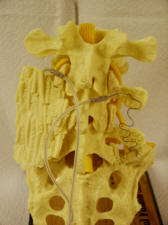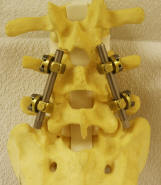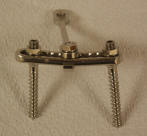Fusion
Fusion actually means the growing together of the
bones of several different vertebral body segments. This is
accomplished in the lumbar spine by several different means.
-
 laying bone along the gutters of the spine, over
the transverse processes; this should result in a fusion mass laying bone along the gutters of the spine, over
the transverse processes; this should result in a fusion mass
- the bone graft may consist of the removed bone
from the spine itself
- the bone graft may consist of bone taken from a
donor site on the patient, such as the hip
- the bone graft may consist of a combination of
the above
- bone growth enhancing products may be mixed in
with the bone to help it to grow
- in the near future, products such as bone
morphogenic protein may be available on a widespread basis
- a bone growth stimulator may be incorporated to
promote bone growth
- placing bone within the interspace between adjacent
vertebral bodies, with the goal that the bodies themselves fuse together
- combination of bone in the lateral gutters as well
as between the vertebral bodies
Seen above, on the right, is a model of a lumbar
spine, with bone graft laid over the transverse processes. Under the
grafted bone is a bone growth stimulator. The wires of the stimulator
can be seen.
 Often, instruments or hardware are used to help with
the fusion. These are not essential, but do help to promote a good, solid
fusion. The instruments help to prevent any "micromotion" while
the bone graft is healing. {On the left is a spine model with pedicle
screws placed. A rod is connecting the screws on both sides} Often, instruments or hardware are used to help with
the fusion. These are not essential, but do help to promote a good, solid
fusion. The instruments help to prevent any "micromotion" while
the bone graft is healing. {On the left is a spine model with pedicle
screws placed. A rod is connecting the screws on both sides}
One can think of the analogy of a broken
porcelain plate. It is well and good to apply glue to the edges, but
unless the pieces remain stable and immobile relative to each other, the
pieces of the plate will not adequately fuse together. And likewise
with the spine.
  The instruments themselves are not strong enough to
withstand the years of punishment the wear and tear of the body will place
upon them, and they will break and fail. They are only meant as a
temporary fixation device, until the bone from the fusion has healed.
One's own bone is, in the long run, much stronger than the titanium and
steel hardware implanted within the body. Pictured above are a screw
and plate set, and a rod, used for a typical instrumented fusion.
There are many different types of hardware manufactured. The instruments themselves are not strong enough to
withstand the years of punishment the wear and tear of the body will place
upon them, and they will break and fail. They are only meant as a
temporary fixation device, until the bone from the fusion has healed.
One's own bone is, in the long run, much stronger than the titanium and
steel hardware implanted within the body. Pictured above are a screw
and plate set, and a rod, used for a typical instrumented fusion.
There are many different types of hardware manufactured.
Approaches to the lumbar spine can be either from the
front (anterior, through the abdomen), or from the back (posterior)
Posterior placement of instruments
Anterior placement of instruments
SMOKING has been
shown to reduce the likelihood of successful healing of a fusion mass,
particularly with posterlateral fusions.
|

